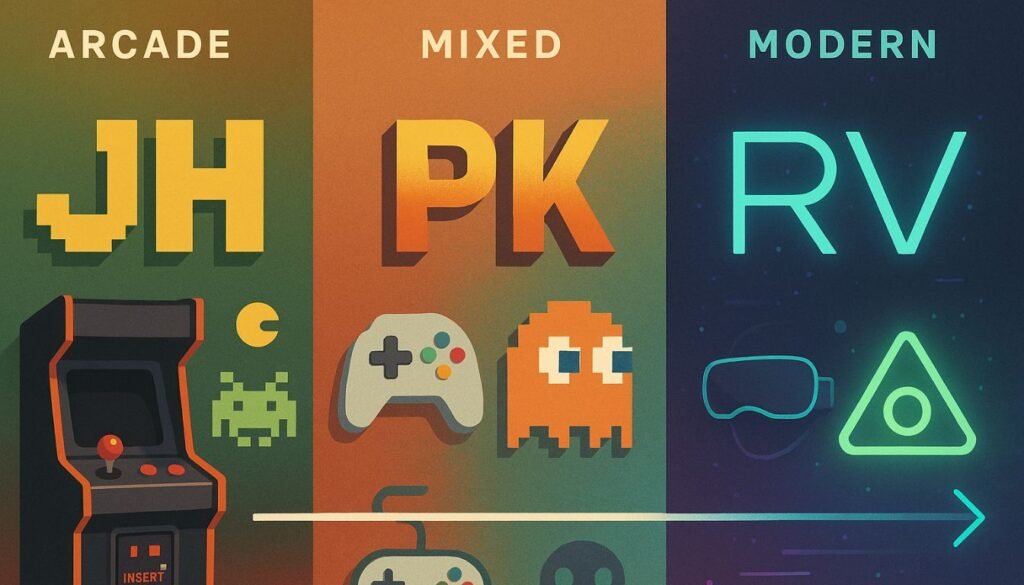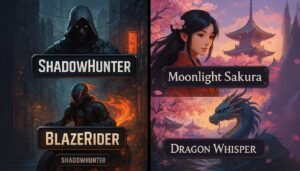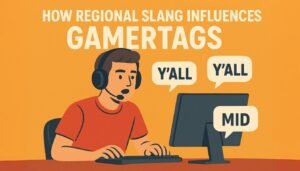
Hey, you ever think about how your gaming name says so much about you? Like, back when you first hopped online, you might’ve ended up with something wild like “xXShadowSlayer69Xx” just to snag a unique tag.
Gaming names—gamertags, usernames, whatever you call ‘em—have changed a ton over the years. They’ve gone from quick arcade initials to full-on personal brands. Let’s walk through this journey, from number-heavy chaos to sleek, minimalist vibes, and toss in some key points to break it down along the way.
Back in the Day: Arcades and Initials
Picture yourself in the 1970s, crowding around a Pac-Man or Space Invaders machine at the arcade. You finally crush the high score, and you get to type in three letters—that’s it! Most people went with stuff like “AAA” or “GOD” to show off or just goof around. Tech was so basic back then, there was no space for anything fancy, let alone numbers. Those initials were your moment to shine on the leaderboard until someone else came along.
- Limited tech shaped names: Arcade machines only allowed three characters, so players got creative with short, punchy initials.
- No lasting identity: Names reset with each game, so they were more about bragging rights than building a persona.
By the 1990s, PC games like Doom let you play with buddies over a local network, but names were still pretty basic, like “Player 1.” Without online systems, your name didn’t stick around long-term.
The 2000s: Numbers, Xs, and Edgy Vibes
Everything changed when online gaming hit big with Xbox Live in 2002. Suddenly, you had a gamertag—a unique name that followed you across games, tied to a profile with achievements and all. It was a game-changer!
But here’s the problem: everyone wanted cool names like “Shadow” or “Killer,” and those got taken fast. So, players started piling on numbers, Xs, and crazy combos to stand out, like “xXx_DarkSniper_69” or “EliteGamer123.” These tags screamed “I’m tough!”—perfect for teens dominating Halo lobbies.
- Numbers as a fix: With popular names gone, adding digits like “420” or “123” was an easy way to make a taken name yours.
- Game style mattered: Shooters like Battlefield leaned on numbers and symbols for quick, unique tags, while RPGs like World of Warcraft banned numbers to keep names immersive, like “Arthas” or “Stormblade.”
Why all the numbers? Platforms needed every name to be unique, so if “Dragon” was taken, you’d go for “Dragon420.” Studies on games like Battlefield show numbers and symbols were super common in shooters because they helped track players without needing deep meaning.
Meanwhile, World of Warcraft pushed for story-rich names to fit its fantasy world, showing how the game you played shaped your tag.
Mid-2000s to 2010s: Getting Clever and Social
As gaming got more social, names started to chill out a bit. By the mid-2000s, it wasn’t just about scaring your opponents—it was about connecting with friends. Platforms like Steam (2003) and PlayStation Network (2006) made communities a big deal, and names became funnier or nerdier.
You’d run into tags like “ObiWanCanBlowMe” or “CtrlAltDefeat,” perfect for cracking up your clan in chat. A buddy of mine had “xX_Kiss_OF_ThE_WinD_Xx” as a kid because he thought it was poetic, but years later, he was like, “What was I thinking?”
- Names as icebreakers: Puns and pop culture references made your tag a conversation starter in forums or clans.
- Platform changes helped: Xbox’s 2019 update added suffixes like “Shadow#1234,” letting you pick a base name without extra numbers, though some gamers felt it made names less special.
This shift was all about gaming becoming a social hangout. Clans, forums, and early streaming meant your name was how you bonded with others. Platforms also got smarter—Xbox’s suffix system meant you could grab “Shadow” with a number tag instead of piling on random digits.
Some folks grumbled that it felt like Discord’s four-digit codes, which nobody remembers to share, but it gave players more room to pick what they wanted.
The 2020s: Minimalist Names and Building a Brand
Fast forward to 2025, and gaming names are all about keeping it simple and sharp. Think of pros like “Ninja” or “Shroud”—short, catchy tags that are basically brands. With Twitch and YouTube turning gamers into stars, your name’s gotta be easy to say, search, and slap on a hoodie.
Nobody wants a tag that looks like a password, so guides for Steam suggest sticking to 5-25 characters and skipping extra numbers or symbols. It’s all about a name that sticks.
- Streaming drove the change: Short, memorable names help streamers stand out and build a following.
- Broader trends align: Name tags at 2025 gaming cons are going sleek with bold designs and QR codes, and gaming names are following suit.
This minimalist vibe ties into bigger trends. Name tags at real-world events are getting clean and bold, with stuff like QR codes to link profiles, and you can see that influencing gaming.
Tools like gamertag generators are a big help now, spitting out short, unique names like “ChillPlayElf” for cozy gamers while checking availability. Plus, platforms like Discord and Steam make it easier to use one name across games, so you’re not juggling a million tags.
Why It All Matters
Your gaming name’s more than just a label—it’s how you show up in the world. From arcade initials to pro-level brands, these names show how gaming’s gone from a small hobby to a massive global scene. The shift to minimalist tags reflects that growth, but it’s not without drama.
Some folks say suffixes and forced numbers water down your vibe, while others love the freedom to grab their dream name. Toxic names are still an issue too, though platforms are cracking down.
- Names shape culture: They let you express yourself and build communities, but they can also spark toxicity or identity theft.
- Future’s looking sleek: As VR and metaverse games grow, we might see AI helping pick tags or cross-platform IDs that follow you everywhere.
Whether you’re rocking “PixelPal” or sticking with “Sniper420,” your name’s a piece of gaming history. It’s like picking your coffee order—it says something about you, and it’s fun to see how it’s changed.
A Quick Look at the Journey
| Era | When | What Names Looked Like | Examples | Why It Happened |
|---|---|---|---|---|
| Arcades | 1970s-1990s | Three-letter initials | “AAA”, “GOD” | Limited tech, high-score focus |
| Early Online | Early 2000s | Numbers, Xs, edgy combos | “xXx_DarkLord_xXx”, “Killer69” | Unique name rules, competitive vibe |
| Social Gaming | 2000s-2010s | Puns, pop culture nods | “CtrlAltDefeat”, “YodaBest” | Community focus, social platforms |
| Minimalist Branding | 2020s-Now | Short, clean, brand-friendly | “Ninja”, “LilyPichu” | Streaming, esports, easier systems |
So, next time you’re picking a gamertag, think about what you want it to say. You going for that early 2000s wild energy or a slick 2025 brand? Either way, it’s your stamp on the gaming world.



